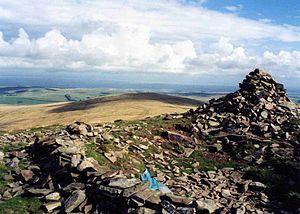Brae Fell: Difference between revisions
Created page with "{{Infobox hill |name=Brae Fell |county=Cumberland |range=Lake District Northern Fells |picture=Brae_Fell_from_Little_Sca_Fell.jpg |picture caption=Brae Fell seen from the cair..." |
No edit summary |
||
| (One intermediate revision by the same user not shown) | |||
| Line 2: | Line 2: | ||
|name=Brae Fell | |name=Brae Fell | ||
|county=Cumberland | |county=Cumberland | ||
|range= | |range=Caldbeck Fells | ||
|picture=Brae_Fell_from_Little_Sca_Fell.jpg | |picture=Brae_Fell_from_Little_Sca_Fell.jpg | ||
|picture caption=Brae Fell seen from the cairn on Little Sca Fell. | |picture caption=Brae Fell seen from the cairn on Little Sca Fell. | ||
| Line 11: | Line 11: | ||
|longitude=-3.10649 | |longitude=-3.10649 | ||
}} | }} | ||
'''Brae Fell''' is a fell in [[Cumberland]], in the [[Lake District]], situated seven miles north of [[Keswick]] it reaches a height of 1,923 feet and is regarded as part of the [[Caldbeck]] | '''Brae Fell''' is a fell in [[Cumberland]], in the [[Lake District]], situated seven miles north of [[Keswick]] it reaches a height of 1,923 feet and is regarded as part of the [[Caldbeck Fells]] along with [[High Pike (Caldbeck)|High Pike]] and [[Carrock Fell]] even though it has ridge links to the Uldale Fells. The fell's name is from the the Northumbrian/Scots dialect in which a 'brae' is a hillside or slope. | ||
==Landscape== | ==Landscape== | ||
Brae Fell is large and grassy and is really an outlying part of [[Great Sca Fell]] being situated on that fell's northern ridge separated by a col with a height of approximately | Brae Fell is large and grassy and is really an outlying part of [[Great Sca Fell]] being situated on that fell's northern ridge separated by a col with a height of approximately 1,870 feet. With a height of less than 2000 feet and prominence of around 52 feet it fails to be a fell of real importance. Alfred Wainwright gives it a chapter in his ''Pictorial Guide to the Lakeland Fells'', being less than complimentary, saying, “If all hills were like Brae Fell there would be far fewer fell walkers”. It is best viewed from the low ground to the north where it shows off its full height. Brae Fell was mined in the nineteenth century for lead, the mine lies on its eastern slopes just above Roughton Gill and there are large spoil tips remaining to this day. | ||
==Ascents== | ==Ascents== | ||
| Line 20: | Line 20: | ||
==Summit== | ==Summit== | ||
The top of the fell is strewn with a few boulders and there is a fair sized | The top of the fell is strewn with a few boulders and there is a fair sized cairn which is a landmark for several miles around. The view from the summit is one of the finest in the Northern Fells, with the panorama north taking in the Solway Firth, Galloway and the northern [[Pennines]]. | ||
==References== | ==References== | ||
*{{Wainwright|5}} | *{{Wainwright|5}} | ||
* {{Birkett}} | *{{Birkett}} | ||
{{Wainwrights|5}} | {{Wainwrights|5}} | ||
Latest revision as of 12:34, 27 June 2017
| Brae Fell | |||
| Cumberland | |||
|---|---|---|---|
 Brae Fell seen from the cairn on Little Sca Fell. | |||
| Range: | Caldbeck Fells | ||
| Summit: | 1,923 feet NY288351 54°42’21"N, 3°6’23"W | ||
Brae Fell is a fell in Cumberland, in the Lake District, situated seven miles north of Keswick it reaches a height of 1,923 feet and is regarded as part of the Caldbeck Fells along with High Pike and Carrock Fell even though it has ridge links to the Uldale Fells. The fell's name is from the the Northumbrian/Scots dialect in which a 'brae' is a hillside or slope.
Landscape
Brae Fell is large and grassy and is really an outlying part of Great Sca Fell being situated on that fell's northern ridge separated by a col with a height of approximately 1,870 feet. With a height of less than 2000 feet and prominence of around 52 feet it fails to be a fell of real importance. Alfred Wainwright gives it a chapter in his Pictorial Guide to the Lakeland Fells, being less than complimentary, saying, “If all hills were like Brae Fell there would be far fewer fell walkers”. It is best viewed from the low ground to the north where it shows off its full height. Brae Fell was mined in the nineteenth century for lead, the mine lies on its eastern slopes just above Roughton Gill and there are large spoil tips remaining to this day.
Ascents
Brae Fell is often climbed in conjunction with other fells in the area. A direct ascent of the fell is usually undertaken from the minor road that skirts the northern slopes, there is no fence so the climb can start anywhere along its length. There is a vague path amongst the grass which leads to the summit.
Summit
The top of the fell is strewn with a few boulders and there is a fair sized cairn which is a landmark for several miles around. The view from the summit is one of the finest in the Northern Fells, with the panorama north taking in the Solway Firth, Galloway and the northern Pennines.
References
- Wainwright, Alfred: A Pictorial Guide to the Lakeland Fells, Book Five — The Northern Fells (1962)
- Bill Birkett: Complete Lakeland Fells, ISBN 0-00-713629-3